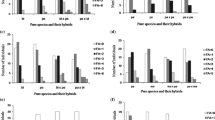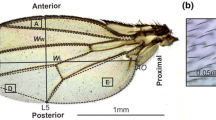Abstract
In this work we investigate the effect of interspecific hybridization on wing morphology using geometric morphometrics in the cactophilic sibling species D. buzzatii and D. koepferae. Wing morphology in F1 hybrids exhibited an important degree of phenotypic plasticity and differs significantly from both parental species. However, the pattern of morphological variation between hybrids and the parental strains varied between wing size and wing shape, across rearing media, sexes, and crosses, suggesting a complex genetic architecture underlying divergence in wing morphology. Even though there was significant fluctuating asymmetry for both, wing size and shape in F1 hybrids and both parental species, there was no evidence of an increased degree of fluctuating asymmetry in hybrids as compared to parental species. These results are interpreted in terms of developmental stability as a function of a balance between levels of heterozygosity and the disruption of coadaptation as an indirect consequence of genomic divergence.


Similar content being viewed by others
Abbreviations
- FA:
-
Fluctuating asymmetry
- DA:
-
Directional asymmetry
References
Alibert P, Auffray JC (2003) Genomic coadaptation, outbreeding depression and developmental instability. In: Polak M (ed) Developmental instability: causes and consequences. Oxford University Press, New York
Auffray JC, Alibert P, Renaud S et al (1996) Fluctuating asymmetry in Mus musculus subspecific hybridization. In Marcus LF (ed) Advances in morphometrics. Plenum Press, New York
Averof M, Patel NH (1997) Crustacean appendage evolution associated with changes in Hox gene expression. Nature 388:682–686
Bookstein FL (1991) Morphometric tools for landmark data: geometry and biology. Cambridge University Press, Cambridge
Bookstein FL (1996) Biometrics, biomathematics and the morphometric synthesis. Bull Math Biol 58:313–365
Cannon WB (1932) The wisdom of the body. Norton, New York
Carreira VP, Soto IM, Hasson E et al (2006) Patterns of variation in wing morphology in the cactophilic Drosophila buzzatii and its sibling D. koepferae. J Evol Biol 19:1275–1282
Carrol SB, Weatherbee SD, Langeland JA (1995) Homeotic genes and the regulation and evolution of insect wing number. Nature 375:58–61
Conner JK, Hartl DL (2004) A primer of ecological genetics. Sinauer Associates, Sunderland
Cowley DE, Atchley WR (1988) Quantitative genetics of Drosophila melanogaster. II. Heritabilities and genetic correlations between sexes for head and thorax traits. Genetics 119:421–433
David J (1962) A new medium for rearing Drosophila in axenic conditions. Dros Inf Serv 36:128
David JR, Gibert P, Pétavy G et al (2002) Variable modes of inheritance of morphometrical traits in hybrids between Drosophila melanogaster and Drosophila simulans. Proc Roy Soc Lond B 269:127–135
David JR, Gibert P, Legout H et al (2005) Isofemale lines in Drosophila: an empirical approach to quantitative trait analysis in natural populations. Heredity 94:3–12
Debat V, David P (2001) Mapping phenotypes: canalization, plasticity and developmental stability. Trends Ecol Evol 16:555–561
Dryden IL, Mardia KV (1998) Statistical shape analysis. Wiley, Chichester
Endler J (1977) Geographic variation, speciation and clines. Princeton University Press, Princeton
Fanara JJ, Fontdevila A, Hasson E (1999) Oviposition preference and life history traits in the cactophilic sibling species Drosophila koepferae and Drosophila buzzatii in association to their natural host. Evol Ecol 13:173–190
Ferguson M (1986) Developmental stability of rainbow trout hybrids: genomic coadaptation or heterozygosity? Evolution 40:323–330
Fontdevila A, Pla C, Hasson E et al (1988) Drosophila koepferae: a new member of the Drosophila serido (diptera-Drosophilidae) super-species taxon. Ann Entomol Soc Am 81:380–385
Gómez GA, Hasson E (2003) Transpecific polymorphisms in an inversion linked esterase locus in Drosophila buzzatii. Mol Biol Evol 20:410–423
Graham JH (1992) Genomic coadaptation and developmental stability in hybrid zones. Acta Zool Fenn 191:121–131
Graham JH, Freeman DC, Emlen JM (1993) Antisymmetry, directional symmetry, and dynamic morphogenesis. Genetica 89:121–137
Hasson E, Naveira H, Fontdevila A (1992) The breeding sites of the Argentinian species of the Drosophila mulleri complex (subgenus Drosophila-repleta group). Rev Chil Hist Nat 65:319–326
Hedrick P, Jain S, Holden L (1978) Multilocus systems in evolution. Evol Biol 11:101–184
Kearsey MJ, Kojima K (1967) The genetic architecture of body weight and egg hatchability in Drosophila melanogaster. Genetics 56:23–37
Klingenberg CP, McIntyre S (1998) Geometric morphometrics of developmental instability: analyzing patterns of fluctuating assymetry with Procrustes methods. Evolution 52:1363–1375
Klingenberg CP, McIntyre GS, Zaklan SD (1998) Left-right assymetry of fly wings and the evolution of body axes. Proc Roy Soc Lond B 265:1255–1259
Klingenberg CP, Barluenga M, Meyer A (2002) Shape analysis of symmetric structures: quantifying variation among individuals and asymmetry. Evolution 56:1909–1920
Lamb T, Avise JC (1987) Morphological variability in genetically defined categories of anuran hybrids. Evolution 41:157–165
Leamy L (1984) Morphometric studies in inbred and hybrid house mice. V. Directional and fluctuating asymmetry. Am Nat 123:579–593
Leamy LJ, Doster MJ, Huet-Hudson YM (1999) Effects of methoxychlor on directional and fluctuating assymetry of mandible characters in mice. Ecotoxicology 8:63–71
Lerner IM (1954) Genetic homeostasis. Dover, New York
Liu J, Mercer JM, Stam LF et al (1996) Genetic analysis of a morphological shape difference in the male genitalia of Drosophila simulans and D. mauritiana. Genetics 142:1129–1145
Manfrin MH, Sene FM (2006) Cactophilic Drosophila in South America: a model for evolutionary studies. Genetica 126:57–75
Markow TA, Ricker JP (1991) Developmental stability in hybrids between the sibling species pair, Drosophila melanogaster and Drosophila simulans. Genetica 84:115–121
Markow TA, Ricker JP (1992) Male size, developmental stability, and mating success in natural populations of three Drosophila species. Heredity 69:122–127
Markow TA, Sawka S (1992) Dynamics of male mating success in experimental groups of Drosophila melanogaster (Diptera: Drosophilidae). J Insect Behav 5:375–383
McKenzie JA, Clarke GM (1988) Diazinon resistance, fluctuating asymmetry and fitness in the Australian sheep blowfly, Lucilia cuprina. Genetics 120:213–220
Møller AP, Swaddle JP (1997) Asymmetry, developmental stability, and evolution. Oxford University Press, Oxford
Moraes EM, Spressola VL, Prado PRR et al (2004) Divergence in wing morphology among sibling species of the Drosophila buzzatii cluster. J Zool Syst Evol Research 42:154–158
Naveira O, Fontdevila A (1986) The evolutionary history of Drosophila buzzatii. XII. The genetic basis of sterility in hybrids between D. buzzatii and its sibling D. koepferae from Argentina. Genetics 114:841–857
Norry FM, Vilardi JC, Hasson E (1998) Sexual selection related to developmental stability in Drosophila buzzatii. Hereditas 128:115–119
Otte D, Endler JA (1989) Speciation and its consequences. Sinauer Associates, Sunderland
Palmer AR (1994) Fluctuating asymmetry analyses: a primer. In: Markow TA (ed) Developmental instability: its origins and evolutionary implications. Kluwer Academic Publishers, Dordrecht
Palmer AR, Strobeck C (1986) Fluctuating asymmetry: measurements, analysis, patterns. Annu Rev Ecol Syst 17:391–421
Palmer AR, Strobeck C (1992) Fluctuating assymetry as a measure of developmental stability: implications of non-normal distributions and power of statistical tests. Acta Zool Fenn 191:57–72
Piccinali R, Aguadé M, Hasson E (2004) Comparative molecular population genetics of the Xdh locus in the cactophilic sibling species Drosophila buzzatii and D. koepferae. Mol Biol Evol 21:141–152
Ramos-Onsins S, Segarra C, Rozas J et al (1998) Molecular and chromosomal phylogeny in the obscura group of Drosophila inferred from sequences of the rp49 gene region. Mol Phylogenet Evol 9:33–41
Rego C, Matos M, Santos M (2006) Symmetry breaking in interspecific Drosophila hybrids is not due to developmental noise. Evolution 60:746–761
Robertson FW (1954) Studies in quantitative inheritance. V. Chromosome analysis of crosses between selected and unselected lines of different body size in Drosophila melanogaster. J Genet 52:494–520
Rohlf FJ (1998) TPSSmall©. Free software available at http://www.morph.bio.sunysb.edu/morph/index.html Department of Ecology and Evolution, State University of New York
Rohlf FJ (2001) TPSDig©. Free software available at http://www.morph.bio.sunysb.edu/morph/index.html Department of Ecology and Evolution, State University of New York
Rohlf FJ (2003) TPSRelw©. Free software available at http://www.morph.bio.sunysb.edu/morph/index.html Department of Ecology and Evolution, State University of New York
Rohlf FJ, Marcus LF (1993) A revolution in morphometrics. Trends Ecol Evol 8:129–132
Rohlf FJ, Slice D (1990) Extensions of the procrustes method for the superimposition of landmarks. Syst Zool 39:40–59
Ross KG, Robertson JL (1990) Developmental stability, heterozygosity, and fitness in two introduced fire ants (Solenopsis invicta and S. richteri) and their hybrids. Heredity 64:93–104
Ruiz AH, Wasserman M (1993) Evolutionary cytogenetics of the Drososophila buzzatii species complex. Heredity 70:582–596
Santos M (2001) Fluctuating asymmetry is nongenetically related to mating success in Drosophila buzzatii. Evolution 55:2248–2256
Santos M (2002) Genetics of wing size asymmetry in Drosophila buzzatii. J Evol Biol 15:720–734
Soto IM, Carreira VP, Fanara JJ, Hasson E (2007) Evolution of male genitalia: environmental and genetic factors affect genital morphology in two Drosophila sibling species and their hybrids. BMC Evol Biol 7:77
Van Valen L (1962) A study of fluctuating assymetry. Evolution 16:125–142
Vilela CA (1983) A revision of the Drosophila species group. (Diptera-Drosophilidae). Rev Brasileira de Entomología 27:1–114
Zeng Z, Liu J, Stam LF et al (2000) Genetic architecture of a morphological shape difference between two Drosophila species. Genetics 154:299–310
Acknowledgments
The authors wish to thank E. Soto for help in part of the experiments reported in this paper and to J. N. Thompson jr. for comments that helped to improve this paper. This work was supported by grants of Universidad de Buenos Aires, Agencia Nacional de Promoción Científica y Técnica and Consejo Nacional de Investigaciones Científicas y Técnicas. VC and IS were recipients of postgraduate scholarships of UBA and CONICET, respectively when this work was written. JJF and EH are members of Carrera del Investigador Científico of CONICET.
Author information
Authors and Affiliations
Corresponding author
Appendix
Appendix
Rights and permissions
About this article
Cite this article
Carreira, V.P., Soto, I.M., Fanara, J.J. et al. A study of wing morphology and fluctuating asymmetry in interspecific hybrids between Drosophila buzzatii and D. koepferae . Genetica 133, 1–11 (2008). https://doi.org/10.1007/s10709-007-9176-z
Received:
Accepted:
Published:
Issue Date:
DOI: https://doi.org/10.1007/s10709-007-9176-z




